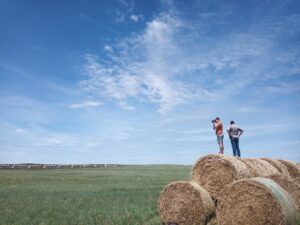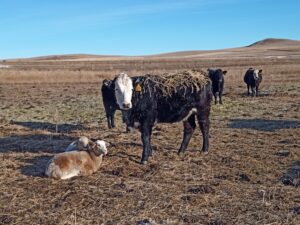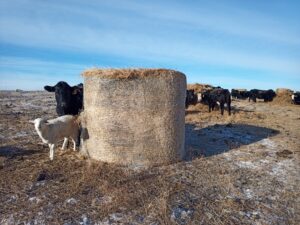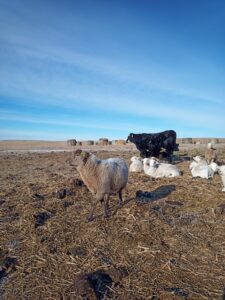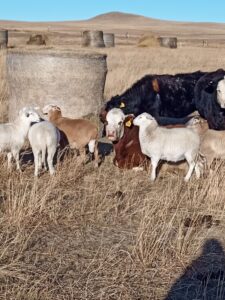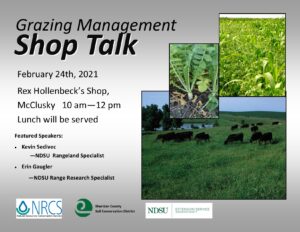Final report for FNC20-1218
Project Information
For over ten years, Drew worked in the oil industry where he became a proficient mechanical engineer. By working in an outside industry, he found and created opportunities to become involved with ranching on a full-time basis. He now manages a cow-calf and small sheep operation along with 970, 110, 240 and 160 acres of native, improved pasture, winter forage/hayland and CRP, respectively. Unfortunately, much of his land was abused prior to his management. Farming practices and severe over grazing left the soil to erode by wind and water. He has worked with NRCS, USFWS, ND State Water Commission and others to transition from a 3-cell pasture rotation relying on dugouts for water to a 20-cell rotation with miles of pipeline, multiple wells (solar and conventional), dams for wildlife, cover crops for bees and soil health, and miles of trees. He continues to work closely with these groups to address resource concerns and make long-term improvements in an effort to revitalize the land and improve wildlife habitat.
Erin has spent the last few years working off the farm to advance her knowledge of production agriculture and is in the process of transitioning back to the farm and ranch. Every position of employment has contributed to her overall understanding of natural resource management. She has also earned an M.S. and is working towards a Ph. D in Range Sciences which helps her to not only design experiments, but also interpret and integrate research from the areas of cropping systems, farm economic management, animal systems, and natural resource management. Currently, she own a small herd of cattle and sheep and manages 340 acres of cropland. She is working to build soil health by managing the land as a pollinator cover crop that will be converted to a perennial system.
This project was designed to address the resource concerns of land that had been historically farmed with no inputs and depleted to a point of no longer being productive. To rejuvenate the land and demonstrate how sustainable agriculture can be adapted to fit an operation, project coordinators used multiple species of livestock and bale grazing. This management strategy allowed us to demonstrate a practice that is ecologically sound, profitable, and socially responsible. Research from multiple universities has shown that bale grazing can increase nutrient capture, cycling, carbon sequestration, and more. It has been shown that it can reduce the direct costs of labor, machinery, maintenance, fuel and fertilizer costs. Additionally, multi-species grazing has the potential to improve forage utilization. What research hasn’t been able to show is the real world application that combines all areas of focus and is available for producers to see the benefits and challenges of adopting a sustainable practice like bale grazing with multiple species. As project coordinators, we feel a social responsibility to provide others with the opportunity to ask questions and consider options for their own operation. It is through projects like this that sustainable agriculture will become a term that is better understood and more readily adopted.
- Improve soil health and fertility
- Increase nutrient cycling and reduce nutrient runoff
- Improve herbage production and forage quality
- Improve residue management
- Improve herd and flock health by extending grazing season
- Observe potential benefits of multi-species in a bale grazing scenario
- Reduce feed and labor costs
- Share findings through self-guided tours, field days, extension publications and testimonials to improve understanding of sustainable agriculture
Cooperators
- (Educator)
Research
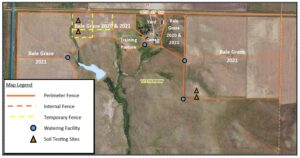
| DATE | PROJECT ACTIVITY | WHO PARTICIPATES |
| April 2020 | Planning meeting | Project Coordinators (PCs): Drew Gaugler, Erin Gaugler; Agronomist: Devin Gaugler; Extension Educators: Hannah Nordby, Kevin Sedivec; Burleigh County Soil Conservation District: Darrell Oswald |
| June-July 2020 | Harvest hay on-site and at other fields | PCs: Drew Gaugler, Erin Gaugler |
| Summer 2020 | Electric high tensile fence modification & installation | PCs: Drew Gaugler, Erin Gaugler |
| Fall 2020 | Purchase, process, and train ewe lambs to respect electric high tensile fences | PCs: Drew Gaugler, Erin Gaugler |
| September-October 2020 | Additional hay hauled to grazing area. Set-up portable windbreak panels. Soil test. | PCs: Drew Gaugler, Erin Gaugler; Hay Hauler: Lane Shone |
| November-December 2020 | Distribute bales and set-up fences for grazing rotations. Bale graze through rotations with use of poly-wire to manage proper utilization of feed and forages. Evaluate body condition of livestock with each rotation. | PCs: Drew Gaugler, Erin Gaugler |
| April 2021 | Planning meeting; Measure/observe litter depth. | PCs: Drew Gaugler, Erin Gaugler; Agronomist: Devin Gaugler; Extension Educators: Hannah Nordby, Kevin Sedivec; Burleigh County Soil Conservation District: Darrell Oswald |
| June-July 2021 | Harvest hay on-site and at other fields | PCs: Drew Gaugler, Erin Gaugler |
| Summer 2021 | Electric high tensile fence installation. Purchase, process, and train additional ewe lambs to respect electric high tensile fences. | PCs: Drew Gaugler, Erin Gaugler |
| September-October 2021 | Additional hay hauled to grazing area. Portable windbreak panels set-up; Attend a virtual shepherd's clinic or school. Soil test. | PCs: Drew Gaugler, Erin Gaugler; Hay Hauler: Lane Shone |
| November-December 2021 | Distribute bales and set-up fences for grazing rotations. Bale graze through rotations with use of poly-wire to manage proper utilization of feed and forages. Evaluate body condition of livestock with each rotation. | PCs: Drew Gaugler, Erin Gaugler |
| January-April 2022 | Continued bale grazing and evaluation of body condition. | PCs: Drew Gaugler, Erin Gaugler |
| April-May 2022 | Planning meeting; Measure/observe litter depth. | PCs: Drew Gaugler, Erin Gaugler; Extension Educators: Hannah Nordby, Kevin Sedivec |
| May-June 2022 | Soil test. | PCs: Drew Gaugler, Erin Gaugler; Agronomist: Devin Gaugler; Extension Educators: Hannah Nordby, Kevin Sedivec; Burleigh County Soil Conservation District: Darrell Oswald |
Multi-species bale grazing was planned to occur across 155 acres of land that had been historically mismanaged by a previous landowner to a point of soil depletion. The project was designed to address resource concerns and demonstrate how sustainable agriculture can be adapted to fit any operation. A planning committee met during the spring of 2020 and 2021 to discuss project objectives, activities/timeline, and outreach efforts. A committee meeting was also held at the end of the project to assess and reflect on its findings.
During the summer of 2020, Drew and I began to modify existing fences which were built for cattle management. Perimeter fences were modified by adding an electric high tensile wire to what was already a 2-wire electric fence. Due to the amount of infrastructure changes required to successfully incorporate sheep, bale grazing only occurred on a portion of the project area during Year 1. Bale grazing expanded to additional acres as more fences were modified during Year 2.
Approximately half of the budgeted sheep were purchased during 2020 and the rest were purchased in 2021. Drew and I chose to do this because we knew that it would take awhile to make the necessary infrastructure changes to successfully train and incorporate sheep. Upon purchase, the ewe lambs were quarantined to the corral for a week and then turned into a training pasture where they were introduced to electric fence. Our interest in hair sheep was because we wanted to minimize the labor involved with managing the animals and we also thought they might respond to electric fence better.

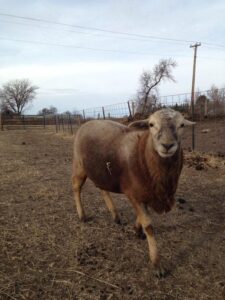
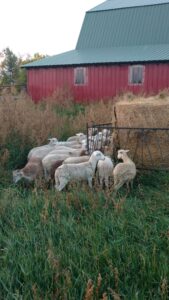
During the summer of 2020 and 2021, hay was harvested both on-site and from nearby fields to support bale grazing on the project area. The amount of additional hay hauled to the site was reflective of the number of animal units that were fed through the winter months. During the winter of 2020, sheep bale grazed alongside 80 bred heifers and 50 bred cows. During the winter of 2021 and early spring of 2022, the sheep bale grazed with 80 bred heifers, 65 yearlings, and 20 bred cows. During the last few rotations, we even calved while bale grazing. We have never done this before and it was interesting to observe the benefits and challenges. For example, livestock were more interested in grazing green grass than eating hay. However, the calves thoroughly enjoyed the extra bale residue and used it as bedding and protection against the wind. Additionally, the bales provided protection for livestock during a couple unseasonal snowstorms.
A benefit of incorporating sheep is that manure distribution was more evenly spread across the field and soil compaction was limited. Additionally, cattle and sheep do not share parasites which in turn breaks the lifecycle. As opposed to cattle, sheep are less selective in browsing near manure deposits which results in improved feeding efficiency. Soil health was monitored by collecting samples before, during and after project completion to monitor nutrients, biological activity, and residue. Photos were also taken throughout the project to use for observation and outreach purposes. Results were evaluated.
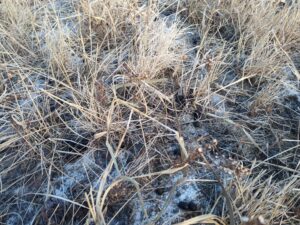
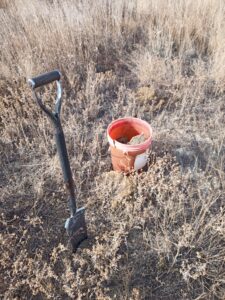
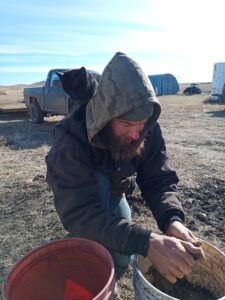
Bales were distributed and temporary fence was installed at the areas designated for bale grazing during the late fall of 2020 and 2021. Sheep and cattle rotationally bale grazed across 20 acres of land during the winter of 2020. After rotations had been grazed, bales from nearby stacks were distributed across the field again and again. During the first year of multi-species bale grazing, Drew and I were hesitant about how sheep would respond to minimal fence infrastructure and training, so we kept them relatively close to the yard where they could be monitored. Additionally, we wanted to create a high amount of impact across these 20 acres as this is where the soil is most unproductive and fragile. Bale grazing through the area on multiple occasions allowed us to see where organic matter and grazing impact was needed.
During the winter of 2021, we expanded our bale grazing impact to approximately 155 acres. We felt comfortable with this expansion because the sheep continued to respect the minimal changes to fencing infrastructure. Additionally, we wanted to expand the soil health benefits of bale grazing to other acres that could benefit from this type of management. Temporary fence materials were used to "strip graze" through the designated bale grazing fields.
Livestock performance was evaluated with each grazing rotation by assessing the animals body condition. The assessment was used to determine the animals nutritional status. North Dakota experienced an extensive drought during the summer of 2021, so forage production and quality was limited. To make sure that the animal's nutritional status would be maintained, mineral lick tubs were offered ad libitum. The lick tubs were helpful because they allowed us to more efficiently utilize the forage that was being offered to the livestock.
Litter depth was assessed during the spring of 2021 and 2022, following bale grazing. A bale was randomly selected from each grazing section and measurements were performed at 0, 10, 20 and 30 feet in each cardinal direction. Photos were also taken throughout the grazing period and into the following spring for observational and outreach purposes.
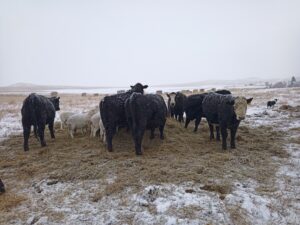
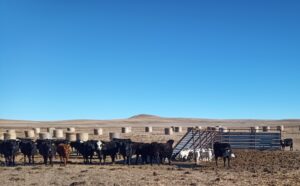
Samples were collected before, during and after project completion to monitor soil nutrients, biological activity, livestock performance and bale grazing residue.
Composite soil samples were collected from the bale grazing areas, as designated on the project map. It is important to note that the 20 acre area had been bale grazed multiple times from 2018-2021. Whereas, the eastern most acres of the project area had not been bale grazed prior to 2021. For this project, the Haney test was collected during the fall of 2020, fall of 2021 and spring of 2022.
Drought conditions were persistent in North Dakota during the summer of 2021. Research suggests that sampling in the fall, following dry conditions, may result in lower than expected soil test results for phosphorus, potassium, and pH. From August - November 2021, however, the project area experienced nearly 10 inches of rain. Literature suggests that sandy, light-colored soils have a limited ability to hold nutrients. Potassium, nitrogen and sulfur, in fact, are the most mobile nutrients and subject to leaching. Soil nutrients should be evaluated deeper in the profile to more accurately quantify the effects of bale grazing. Areas that were directly impacted by bale grazing resulted in greater forage production and quality, which was visually apparent. Producers should, therefore, interpret those soil-test results with caution.
| MULTI-SPECIES BALE GRAZING (20 AC FIELD) | |||
| Soil Analysis | Fall 2020 | Fall 2021 | Spring 2022 |
| 1:1 Soil pH | 8.1 | 8.1 | 8.5 |
| WDRF Buffer | 7.2 | 7.2 | 7.2 |
| 1:1 Soluble Salt | 0.32 | 0.26 | 0.4 |
| Excess Lime | HIGH | HIGH | HIGH |
| Organic Matter | 2.6 | 2.5 | 2.5 |
| CO2-C | 38.1 | 71.5 | 24.2 |
| H2O Total N | 16.1 | 16.5 | 35.9 |
| H2O Organic N | 11.8 | 11.5 | 13.8 |
| H2O Total Organic C | 141 | 89 | 121 |
| H3A Nitrate | 1 | 3.3 | 18.7 |
| H3A Ammonium | 0.8 | 1.2 | 6.2 |
| H3A Inorganic Nitrogen | 1.8 | 4.5 | 24.9 |
| H3A Total Phosphorus | 2 | 1 | 1 |
| H3A Inorganic Phosphorus | 0.7 | 0.5 | 0.2 |
| H3A Organic Phosphorus | 1.4 | 0.4 | 1.1 |
| H3A ICAP Potassium | 49 | 184 | 237 |
| H3A ICAP Calcium | 1742 | 2743 | 2535 |
| H3A ICAP Aluminum | 24 | 20 | 26 |
| H3A ICAP Iron | 4 | 5 | 7 |
| H3A ICAP Sulfur | 9.6 | 23.1 | 30.9 |
| H3A ICAP Zinc | 0.14 | 0.03 | 0.03 |
| H3A ICAP Manganese | 1 | 0.7 | 1.8 |
| H3A ICAP Copper | 0.12 | 0.16 | 0.05 |
| H3A ICAP Magnesium | 320 | 587 | 734 |
| H3A ICAP Sodium | 71 | 30 | 124 |
| % MAC | 26.9 | 80 | 19.9 |
| Organic C:N | 12 | 7.8 | 8.8 |
| Organic N:Inorganic N | 6.5 | 2.5 | 0.6 |
| Organic N Release | 11.8 | 11.5 | 11 |
| Organic N Reserve | 0 | 0 | 2.8 |
| Organic P Release | 1.1 | 0.4 | 0.7 |
| Organic P Reserve | 0.3 | < 0.1 | 0.4 |
| Soil Health Calculation | 7.82 | 10.08 | 6.22 |
| Available N | 24.5 | 28.8 | 64.6 |
| Available P | 4.3 | 2 | 2 |
| Available K | 58.5 | 221 | 283.9 |
| Nutrient Value | 46.58 | 129.7 | 184.03 |
| Traditional N | 1.8 | 6 | 33.7 |
| Haney Test N | 24.5 | 28.8 | 64.6 |
| Lbs N Difference | 22.7 | 22.7 | 30.9 |
| N savings | 14.55 | 14.56 | 19.76 |
Livestock performance was evaluated with each grazing rotation by assessing the animals body condition. The assessment was used to determine the animals nutritional status. Body condition scoring (BCS) of cattle allows producers to assess the fat reserves of cows during various production phases. The aim of BCS is to obtain a simple and reliable measure of the level of body fat reserves in live animals. The scoring system for beef cattle has a range of 1 to 9, with 1 representing very thin cows and 9 representing very fat cows. A cow with a BCS of 5 is said to be in average condition; however, perception of an "average" conditioned cow can vary from producer to producer. Sheep BCS is monitored on a 5-point scale. The ideal score falls between 2.5 to 4, depending on life stage and energy demand.
The winter of 2020 was unseasonably mild and the snow was minimal so the animals performed well and maintained great body condition throughout the bale grazing season. Additionally, the forage that was harvested the previous season was of good quality and helped to maintain livestock performance. North Dakota experienced an extensive drought during the summer of 2021, so forage production and quality was limited. To make sure that the animal's nutritional status would be maintained, mineral lick tubs were offered ad libitum. The lick tubs were helpful because they allowed us to more efficiently utilize the forage that was being offered to the livestock. Additionally, the livestock were able to better maintain their body condition and performance in the bale grazing system.
| BODY CONDITION SCORE (BCS 1-9) OF CATTLE | ||
| Year | Average | |
| 2020-2021 | BCS-Pre Bale Graze | BCS-Post Bale Graze |
| Heifers | 4.5 | 4.5 |
| Cows | 5.5 | 5 |
| 2021-2022 | BCS-Pre | BCS-Post |
| Heifers | 5 | 4.5 |
| Cows | 5.5 | 5 |
| BODY CONDITION SCORE (BCS 1-5) OF SHEEP | ||
| Year | Average | |
| 2020-2021 | BCS-Pre Bale Graze | BCS-Post Bale Graze |
| Ewe Lambs | 3 | 3.5 |
| 2021-2022 | BCS-Pre Bale Graze | BCS-Post Bale Graze |
| Ewe Lambs | 3 | 3 |
| Ewes | 3.5 | 3.5 |
Litter depth was assessed during the spring of 2021 and 2022, following bale grazing. A bale was randomly selected from each grazing section and measurements were performed at 0, 10, 20 and 30 feet in each cardinal direction. Photos were also taken throughout the grazing period and into the following spring for observational and outreach purposes.
In the 20 acre field, where bale grazing occurred multiple times throughout the winter of 2020, the litter depth was spread relatively evenly across the surface at a depth of 0.5-1". It is important to note that the winter of 2020 was mild and very little snowfall occurred, so livestock had continued access to residue. During the spring of 2021, it was observed that plants had little to no trouble growing through the remaining residue.
The winter of 2021 was more typical than 2020, with snowfall throughout the season and a couple storms in the early spring of 2022. Because of the snowfall, livestock tended to congregate around the bales, eat until filled, then used the residue as bedding. The bedding was sometimes picked through, though this was often weather dependent. As previously mentioned, we ended up calving while bale grazing during the spring of 2022. Once things began to melt off during the spring, any of the residue or bedding that had been snowed over, was readily picked through by the sheep and cattle. However, the livestock were less interested in the residue once the grass began to green up. While the average litter depth was nearly 1", the distribution across the area was less consistent. The uneven distribution likely occurred because we bale grazed in a larger area during Year 2 as compared to Year 1. Additionally, we had a few storm events that required us to move livestock into a new section of bales to make sure that they had adequate access to feed. Regardless, during the spring of 2022, it was observed that plants had little to no trouble growing through the remaining residue.
| AVERAGE LITTER DEPTH | |
| 2021 | |
| Distance (feet) | Depth (inches) |
| 0 | 1 |
| 10 | 1 |
| 20 | 0.3 |
| 30 | 0.1 |
| 2022 | |
| Distance (feet) | Depth (inches) |
| 0 | 2 |
| 10 | 1.5 |
| 20 | 0.25 |
| 30 | 0.1 |
Educational & Outreach Activities
Participation summary:
While bale grazing and the incorporation of multiple species has shown benefits, neither management practice has been widely adopted. This project provided both a demonstration of multi-species bale grazing to producers, but also included many outreach efforts. To disseminate information about the project, events and activities, we utilized local networks, social media and posted flyers. Tapping into local networks (NRCS, SCD, ND Grazing Coalition, etc.) was the most effective way to reach our selected audience of farmers and ranchers.
Outreach efforts during the project included the following: mail-box tours, farmer-to-farmer discussions, participation in vendor shows, podcasts, webinars, newsletter articles, features in various newspapers and more.
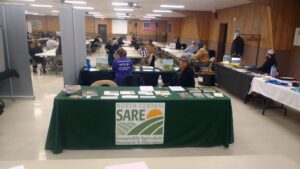
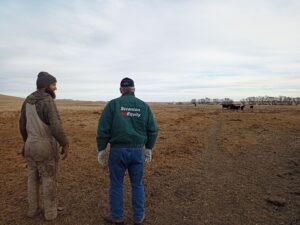
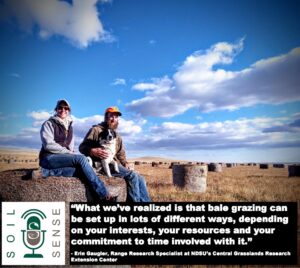
https://anchor.fm/soilsense/episodes/Bale-Grazing-with-Erin-and-Drew-Gaugler-en7atc
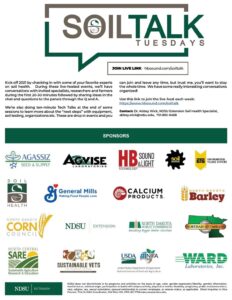
https://www.youtube.com/watch?v=YYu4eqTpqJY
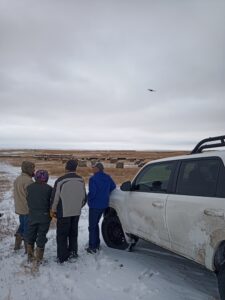
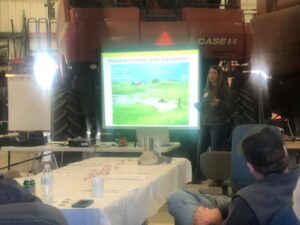
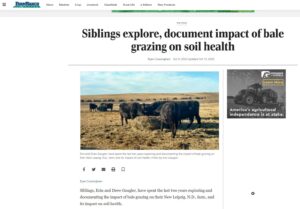
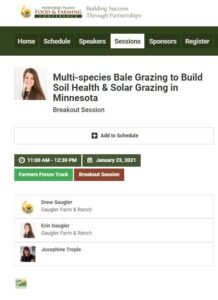
CGREC Newsletter - Spring 2021
